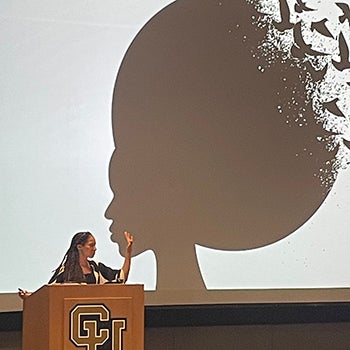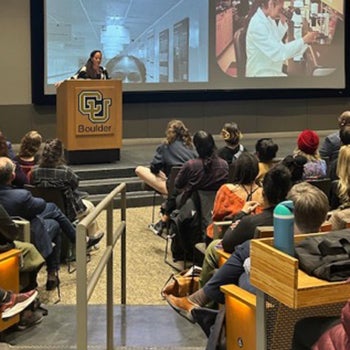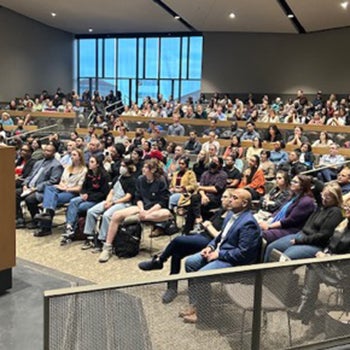By Joe Arney
Photos by Malinda Miller (Engl, Jour’92; MJour’98) and Annie Hergenrader
There is perhaps no more coveted title among the disruptors of Silicon Valley than “innovator.”
It’s a term Ruha Benjamin wants to take back.
The tech set, she argues, has continued to create products and services that offer convenience and demonstrate the power of imagination. But to do so, they have advanced discrimination by ignoring the history of technical advances coming at the expense of marginalized groups.
“Those who’ve created the technical problems that we see here … are constantly putting themselves in the position of the thought leaders for the very problems they’ve been instrumental in creating,” said Benjamin, the Alexander Stewart 1886 professor of African American Studies at Princeton University and founding director of its Ida B. Wells Just Data Lab.
“One of things we could do is to stop calling them innovators. It shouldn’t count as innovation if you’re not wrestling and dealing with the social, ethical and political implications of your work.”
Benjamin visited the University of Colorado Boulder on March 6 to help launch the Center for Race, Media and Technology at the College of Media, Communication and Information, while also serving as the first speaker in the college’s Distinguished Lecture Series.
A need for courageous voices
In introducing Benjamin and the speaker series, Nabil Echchaibi, associate dean of creative and scholarly work at CMCI, talked about a world of growing violence and fear, disinformation, and complicity before hostile powers and technologies.
“In this world, we need more than ever courageous voices, voices that speak truth to power, voices that slow things down so we can see things again,” Echchaibi said.
It’s a fitting overview of key themes in Benjamin’s work. Her four books draw on her extensive research into technology and racism, including what she calls the “New Jim Code,” a nod to both the Jim Crow laws that enforced segregation and the biases encoded into technology. She implored students to play an active role in questioning assumptions about technology and the world around them by bringing historical and cultural contexts to the forefront.
As an example, she showed students something decidedly low tech—a park bench with armrests. She noticed the benches on a trip to the Bay Area, and while she appreciated the convenience, the benches offered the hidden feature of deterring people from sleeping on them—in an area struck by high homelessness amid vast income inequality.
It got worse, as she showed single-seat benches, benches that were caged overnight and a coin-operated bench with retractable spikes on the seat.
Fortunately, that last one was an art project, but Benjamin called it a strong metaphor of something “that’s nominally for everyone, but with forms of harm and exclusion beneath the surface.” Technology, she said, often plays by the same rules, whether it’s algorithms that make assumptions about a student’s test scores based on their ZIP code, or facial recognition technology—deployed in consumer products and by police—that struggles to correctly identify Black faces.
Technology as a mirror
Notably, technology isn’t the problem, she said. Rather, the technology is simply reflecting the biases of the people who create and code it.
“In every conversation about technology, we have to start not with technology’s impact, but with the social inputs,” Benjamin said. “What’s being used to train, to design; what are the values, the ideas, the preexisting forms of hierarchy that are shaping that design process.
“Computational depth without the social and historical depth is, in my view, superficial learning, not deep learning.”
Benjamin covered a range of concepts around artificial intelligence and its hidden costs—labor, societal and environmental—but also challenged students to find ways to use these tools to create positive societal change. She pointed to a project that aimed to use A.I. to better assess patient pain, but the team designing it considered that doctors have historically underdiagnosed pain in Black patients.
“Computational depth without the social and historical depth is, in my view, superficial learning, not deep learning.”
Ruha Benjamin
So rather than train the A.I. on doctors’ notes, they had it crawl through patient-reported data on the pain they experienced, improving accuracy and removing bias.
“This is an example of questioning where we go looking for knowledge and data,” Benjamin said, “and instituting that idea of social and historical literacy into our framing of the problem, which leads us down a different road and gets us perhaps better results.”
In other words, be imaginative about possibility, and don’t get locked into what she called “the default settings.”
“We are in many ways trapped inside the lopsided imaginations of those who monopolize power and resources to benefit the few at the expense of the many,” she said. “The fantasies of these futurists too often rest on the nightmares of others. … How might the power of our collective imagination begin to transform the world around us?”
Bryan Semaan, founder of CMCI’s Center for Race, Media and Technology, had hoped Benjamin would be available to formally launch the center, and her lecture “was beyond anything I could have imagined.”
“What I really hope people took away from this is a new sensibility and ethic for how they can approach every facet of their everyday life,” said Semaan, associate professor of information science and associate chair for undergraduate studies. “So much of what Ruha pointed out are things that exist in our world that are super invisible to many, but hyper visible to others. And I hope people left inspired, and with a greater understanding that not everyone is living in their world in the same way and experiencing life in the same way, but that together we can address these widescale and pressing societal issues.”



